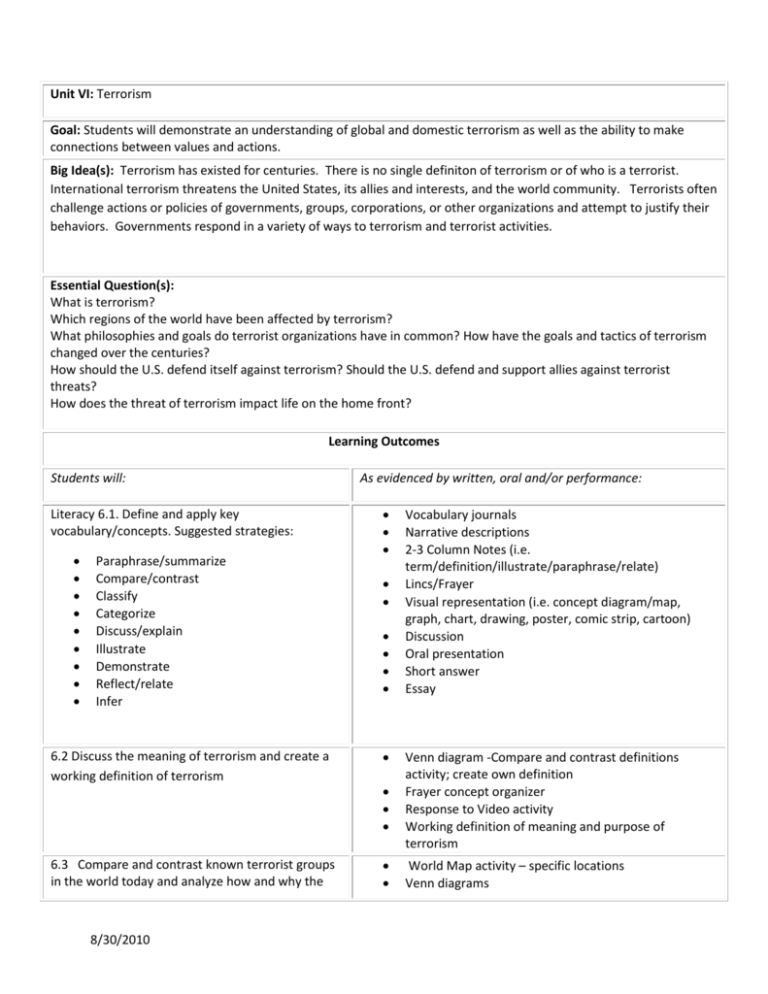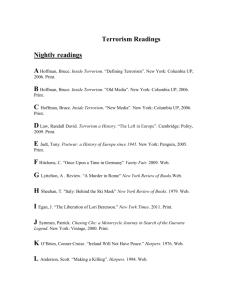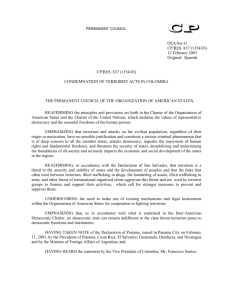Unit 6 - Terrorism
advertisement

Unit VI: Terrorism Goal: Students will demonstrate an understanding of global and domestic terrorism as well as the ability to make connections between values and actions. Big Idea(s): Terrorism has existed for centuries. There is no single definiton of terrorism or of who is a terrorist. International terrorism threatens the United States, its allies and interests, and the world community. Terrorists often challenge actions or policies of governments, groups, corporations, or other organizations and attempt to justify their behaviors. Governments respond in a variety of ways to terrorism and terrorist activities. Essential Question(s): What is terrorism? Which regions of the world have been affected by terrorism? What philosophies and goals do terrorist organizations have in common? How have the goals and tactics of terrorism changed over the centuries? How should the U.S. defend itself against terrorism? Should the U.S. defend and support allies against terrorist threats? How does the threat of terrorism impact life on the home front? Learning Outcomes Students will: Literacy 6.1. Define and apply key vocabulary/concepts. Suggested strategies: Paraphrase/summarize Compare/contrast Classify Categorize Discuss/explain Illustrate Demonstrate Reflect/relate Infer As evidenced by written, oral and/or performance: Vocabulary journals Narrative descriptions 2-3 Column Notes (i.e. term/definition/illustrate/paraphrase/relate) Lincs/Frayer Visual representation (i.e. concept diagram/map, graph, chart, drawing, poster, comic strip, cartoon) Discussion Oral presentation Short answer Essay 6.2 Discuss the meaning of terrorism and create a working definition of terrorism Venn diagram -Compare and contrast definitions activity; create own definition Frayer concept organizer Response to Video activity Working definition of meaning and purpose of terrorism 6.3 Compare and contrast known terrorist groups in the world today and analyze how and why the World Map activity – specific locations Venn diagrams 8/30/2010 goals and tactics of terrorists have changed over the centuries. Regions and countries where terrorist activities have occurred. Philosophies and goals. Tactics 6.4 Research and analyze various terrorist incidents and explain how the terrorist incident affected the countries involved: Geography Economy Politics Culture Global connections 6.5 Assess trends in domestic and international terrorism and the nature of the terrorist threat. 6.6 Discuss how the U.S. seeks to: Ensure America’s homeland security Respond to both domestic and international terrorism Defeat terrorists and their organizations Diminish the underlying conditions that terrorists seek to exploit 8/30/2010 Timeline/ Exhibit tracing the history and evolution of terrorism, showing how the tactics and objectives have changed from the French Revolution to the present. group attributes graphic organizer Help wanted advertisement for a terrorist Political cartoon Cause and effect diagram Graphic organizer - terrorist networks, etc. Personality profile of a terrorist group member (a known leader or an imaginary composite of a typical member). (H) Assessment of the viability of various groups –>achieve their goals or fail. (H) Assessment of an organization: freedom fighters, terrorists, or other? Is their cause just? Do the ends justify the means? (H) Research paper Graphic organizer Compare and critique differing perspectives on the incident using political cartoons from the U.S. and around the world. (H) Use information from organizer to create one of the following: o Poster using maps, pictures, diagrams, etc. o Class presentation o Newspaper article o Letter to editor written from viewpoint of a victim or the terrorist o Eyewitness account of a terrorist event o Briefing to the Secretary of state Cause and effect diagram Graphic organizer – terrorist networks Prediction of possible threats (future attacks, tactics and regions affected) including rationale for prediction. Venn diagram – domestic vs. international Poster Discussion of future of terrorism Briefing to the State Department (H) Prediction of future policy directions Public service announcement of what the United States and its allies are doing to contain the dangers and sponsors of worldwide terrorism. Poster/presentation/ exhibit of leading technology development to effectively combat terrorism Simulation: military intelligence/ FBI/CIA/Homeland Security and/or other role play 6.7 Examine a range of U.S. policy responses toward terrorism , with consideration to: why the U.S. is a target what the possible threats are what issues complicate the response. what values underlie specific policy recommendations and the trade-offs that accompany each choice Venn Diagram - comparison of differing perspectives T-Chart – pros & cons Articulation of own considered perspective Choices Simulation: students assume the role of advocates for four options followed by deliberation on the pros and cons of each. Student developed options and application of their views to hypothetical crises. (H) Discussion of relative merits and draw backs of potential solutions. Resources: http://future.state.gov/educators/lessons/43401.htm Contains info sheets, worksheets, activities, and lesson plans. http://future.state.gov/documents/organization/45696.pdf Choices: Brown University – Terrorism unit http://www.terrorism-research.com/history/ U.S. Government Sources � http://www.state.gov : U.S. Department of State homepage � http://www.state.gov/s/ct : Counterterrorism Office of the U.S. Department of State � http://www.state.gov/s/ct/rls/pgtrpt : U.S. Department of State’s annual report on “Patterns of Global Terrorism” � http://www.state.gov/coalition/ : Diplomacy and the global campaign against Terrorism � http://www.state.gov/secretary/rm/2002 : The Secretary of State’s speeches and remarks � http://www.whitehouse.gov/response/index.html : The President’s responses to terrorism � http://www.defenselink.mil : The U.S. Department of Defense � http://www.state.gov/coalition/cr/fs/5048.htm : Fact sheet for students on September 11 terrorist attacks � http:www.state.gov/g/drl/rls/hrrpt : Country Reports on Human Rights Practices submitted annually by the U.S. Department of State to the U.S. Congress � http://www.state.gov/r/pa/ho/pubs/fs/5902.htm : Chronology of significant terrorist incidents from 1961 until 2001 � http://www.state.gov/r/pa/ei/bgn/ : Background Notes providing information on individual countries � http://www.cia.gov/cia/publications/factbook : The World Factbook produced by the Central Intelligence Agency Non-Governmental Sources � http://www.hrw.org : Human Rights Watch � http://www.amnesty.org : Amnesty International Media Sources 8/30/2010 � http://www.nytimes.com : New York Times � http://www.washingtonpost.com : Washington Post � http://www.bbc.co.uk : The BBC � http://www.cnn.com : CNN � http://www.msnbc.com : MSNBC Common Formative Assessment(s) Teacher generated 8/30/2010 Summative District Assessment(s) To be determined






